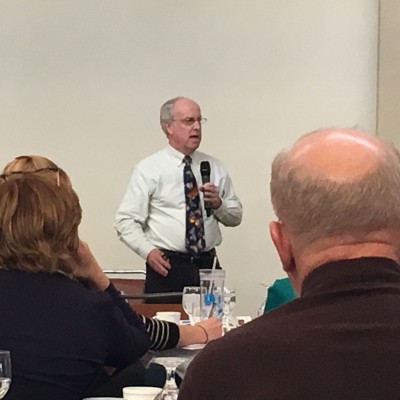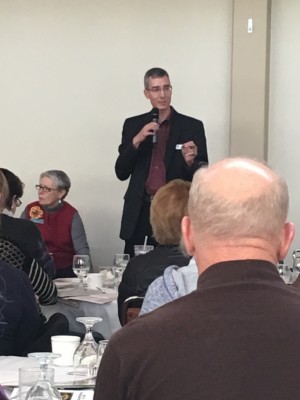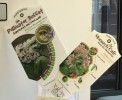By Dawn Weber
Board Member-at-Large, St. Louis Wild Ones
The Grow Native! Southwestern Illinois Event Committee presented a great lineup of speakers for the Native by Design: Landscapes Beyond Beauty workshop in Edwardsville, IL on February 26. The presentations focused on frontline concepts surrounding the value of native plants in our landscapes.
I arrived early and the registration area was already crowded, which was a great sign that the attendees were excited to be there!
The keynote speaker was Doug Tallamy, whose research goals are to better understand the many ways insects interact with plants and how such interactions determine the diversity of animal communities.This event was my second opportunity to hear him speak, and each time I left more inspired than when I arrived. If you’ve not had the opportunity to hear him speak, here is an online video that you can watch.
Tallamy’s topic for this workshop was “The Chickadee’s Guide to Gardening”. An op-ed post with the same name and similar topic appeared in the New York Times last spring.
I really like the example of the chickadee, because it uses what can be an overwhelming topic and brings it to a level that is easier to relate to, help *this* bird. His presentation included the familiar messages:
- Sterile landscapes starve birds
- We can fix it by creating food webs
- Building habitat with native plants
- The time to do it is now.
My favorite idea from his presentation, on the topic of habitat that does not supply food, was “How many times would you go back to a grocery store to get food if the shelves were empty?” Food, or lack thereof, for thought.
The Powerpoint of his presentation will be available on the Grow Native! website until March 20. While the presentation does not have a lot of text, the 400+ pictures are fantastic. If you do take a look, be sure not to miss the caterpillar with a very presidential candidate-like appearance!
Mitch Leachman, Executive Director of St. Louis Audubon Society, presented “Nature Is Not Neat”. His commentary reminded us that building habitat includes shelter and other needs. Small changes that have a positive impact:
- Leaving leaf litter for overwintering insects
- Bare dirt for ground-nesting bees
- Creating brush piles for shelter
One great tip (I think from a Master Gardener) was that if you don’t want to leave plants standing through the winter in a highly visible area, you can cut them down and take those stems and seed heads to a less visible part of the yard and still add to your native habitat.
We heard short presentations about other efforts on the Illinois side of the river, such as:
- Heartland Prairie in Alton
- Green initiatives at Lewis & Clark Community College
- Stewardship and maintenance considerations when planning native gardens
- Costello Confluence Field Station
Grow Native! displayed new “Pollinator Buffet” plant tags, similar to the Monarch Cafe tags that we saw last year.
Look for these tags to know that you are buying nursery-propagated native plants.
I saw some old friends, made some new ones, and got a good dose of native plant enthusiasm to carry me over until spring arrives!






Thank you so much for posting this event! Dr. Doug Tallamy does a beautiful job of explaining the Need for Natives across the Planet……
Thanks for the links!
Thanks! Will enjoy reviewing Tallamy’s photos. Love the new plant tags.
Even though I attended the event, I gained a lot from your review. I especially appreciate having all of the related links. Thanks a lot.
Dawn, this is a beautiful summary of Doug Tallamy’s and Mitch Leachman’s points, the best review of their talks I’ve ever read. Your description of the event makes us all wish we had been there. Thanks so much for taking the time to insert all the links.
Thanks Peggy! 🙂